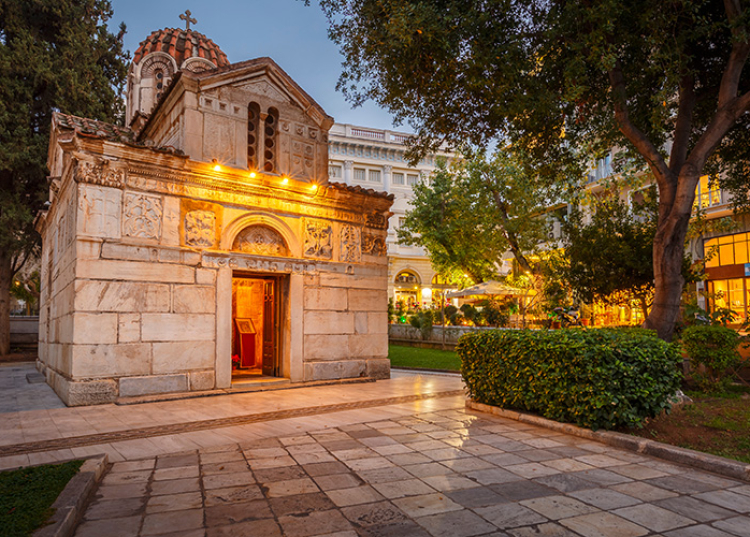The Byzantine Empire is typically characterised by its architectural heritage, rich cultural triumphs and vast scale. Also referred to as the Eastern Roman Empire, or Byzantium, the sprawling empire and its influence stretched from Spain to India. Its capital was in Constantinople, modern-day Istanbul.
In 1453, the Byzantine Empire fell to Ottoman invaders. But its history has been preserved across Europe.
In Greece, a whole host of important Byzantine sites, ruins, structures and museums can be visited. Here are 6 of the country’s greatest Byzantine attractions.

1. Museum of Byzantine Culture - Thessaloniki
The Museum of Byzantine Culture in Thessaloniki is dedicated to exploring various aspects of the Byzantine period, from its beginnings in the third and fourth centuries AD to its fall to the Ottomans in 1453. The museum explores various social aspects relating to this period including politics, ideology, religion and social structures.
From mosaics and icons to ecclesiastic objects and everyday utensils, the museum displays almost 3,000 artefacts from the Byzantine period throughout its eleven rooms, categorising them and creating a chronological narrative for visitors to follow.

2. Kapnikarea
Sitting right in the middle of bustling modern streets, Kapnikarea is a beautiful 11th-century Byzantine church in Athens. Built around 1050 AD, the church was constructed atop the remains of an earlier ancient Greek temple, probably dedicated to either Athena or Demeter.
Kapnikarea looks oddly out of place in the middle of a busy thoroughfare however its beauty is in its size. Small but perfectly formed, the Church of Panaghia Kapnikarea is an excellent example of a well preserved Byzantine building. Inside, visitors can also discover the excellent decorative art, particularly the Mosaic of the Madonna and Child.

3. Byzantine Museum
The Byzantine Museum in Athens contains over 25,000 artefacts of national importance and is a popular attraction for visitors to the Greek capital. The museum’s vast collection covers the Early Christian, Byzantine, Medieval and post-Byzantine eras. It includes religious artefacts, stunning iconography, sculpture, textiles, paintings, manuscripts, jewels, ceramics and art.
The museum is divided in five main sections: From the ancient world to Byzantium; the Byzantine world; intellectual and artistic activity in the 15th century; from Byzantium to the modern era; Byzantium and modern art. The artefacts come from all across Greece as well as from nearby regions where Hellenic and Byzantine culture were prominent.

4. The White Tower of Thessaloniki
The White Tower of Thessaloniki (in greek Lefkos Pyrgos), is a cylindrical stone tower monument and museum in the city of Thessaloniki, capital of the Macedonian region of northern Greece. The current tower was constructed by the Ottomans in the 15th Century, but an older Byzantine structure used to stand at the site.
Today, the ‘White Tower’ hosts a museum with exhibits covering the city’s history through time, from the Byzantines to the Ottomans and much more. It is intended to help visitors and residents to get better acquainted with the city, its monuments and its museums. Visitors can also get great views of the city from the top floor of the White Tower.

5. Benaki Museum
The Benaki Museum in Athens houses over 100,000 artefacts from Greek history and showcases the many eras, civilisations and cultures which have influenced the development of Greece. Spread over a number of locations, the museum ranks among Greece’s foremost cultural institutions.
Among its extensive collections are a wide variety of objects of historical and national importance. Foremost among these is an enormous collection of Greek art and sculpture ranging from Hellenic, Roman and Byzantine Greece to the Ottoman age and right through to modern times. Yet alongside these grand artworks, the museum includes a range of more commonplace items including books, regional costumes, documents and scrolls.

6. Agios Eleftherios
Agios Eleftherios is a very small yet important Byzantine church in Athens known as the little cathedral, one of many religious Byzantine sites.
Built in the twelfth century, Agios Eleftherios was once the main church in Athens. This fact, coupled with the vision of the diminutive church next to the monolith of Athens Cathedral has led to it being known as the “little cathedral”.


